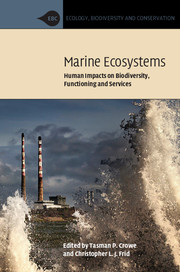Book contents
- Frontmatter
- Contents
- List of contributors
- Part I Key concepts
- 1 Introduction
- 2 Ecosystem services and benefits from marine ecosystems
- 3 Assessing human impacts on marine ecosystems
- 4 Modifiers of impacts on marine ecosystems: disturbance regimes, multiple stressors and receiving environments
- 5 Impacts of changing biodiversity on marine ecosystem functioning
- Part II Impacts of human activities and pressures
- Part III Synthesis and conclusions
- Index
- Plate Section
- References
5 - Impacts of changing biodiversity on marine ecosystem functioning
from Part I - Key concepts
Published online by Cambridge University Press: 05 June 2015
- Frontmatter
- Contents
- List of contributors
- Part I Key concepts
- 1 Introduction
- 2 Ecosystem services and benefits from marine ecosystems
- 3 Assessing human impacts on marine ecosystems
- 4 Modifiers of impacts on marine ecosystems: disturbance regimes, multiple stressors and receiving environments
- 5 Impacts of changing biodiversity on marine ecosystem functioning
- Part II Impacts of human activities and pressures
- Part III Synthesis and conclusions
- Index
- Plate Section
- References
Summary
Introduction
Understanding how changes in biodiversity can lead to changes in the functioning of ecosystems is a critical step for tracing the consequences of human activities through to impacts on ecosystem services. As defined and described in Chapter 1, it is widely recognised that the biodiversity of ecosystems can influence their functioning – the processing of energy and materials – and properties such as stability and total biomass. The relationship between biodiversity and ecosystem functioning has, however, been the subject of extensive and, at times, controversial research over the past two decades, the so-called BEF debate.
The BEF debate rose to prominence in ecology at a conference in Bayreuth in 1992 and has passed through several phases since then, in which the field has expanded in volume, scope, rigour and complexity (Naeem et al., 2009). The first major advances were made in terrestrial ecosystems, particularly grasslands (e.g. Naeem et al., 1994; Tilman et al., 1996). There was, initially, a lag in developing similar levels of understanding for marine ecosystems (Heip et al., 1998), but there is now a substantial body of work covering at least coastal ecosystems (Stachowicz et al., 2007; Naeem et al., 2009). Several authors have described how the structure and functioning of marine systems is different from that of terrestrial systems (e.g. Steele, 1985, 1991; Ormond, 1996; Stachowicz et al., 2007; Naeem, 2012), suggesting that understanding derived from terrestrial systems may not be applicable in a marine context. Indeed, a number of major syntheses have treated the systems separately (e.g. Balvanera et al., 2006; Cardinale et al., 2006). On the other hand, Schmid et al. (2009) argue that because their meta-analysis revealed no differences in the proportion of positive BEF relationships in marine versus terrestrial systems, there is no basis to argue that different mechanisms apply (and see Webb, 2012). An analysis by Crowe et al. (2012) reveals that in general BEF research in marine and terrestrial ecosystems has differed in spatial and temporal scale and approach, making it difficult to draw direct comparisons.
Information
- Type
- Chapter
- Information
- Marine EcosystemsHuman Impacts on Biodiversity, Functioning and Services, pp. 111 - 134Publisher: Cambridge University PressPrint publication year: 2015
